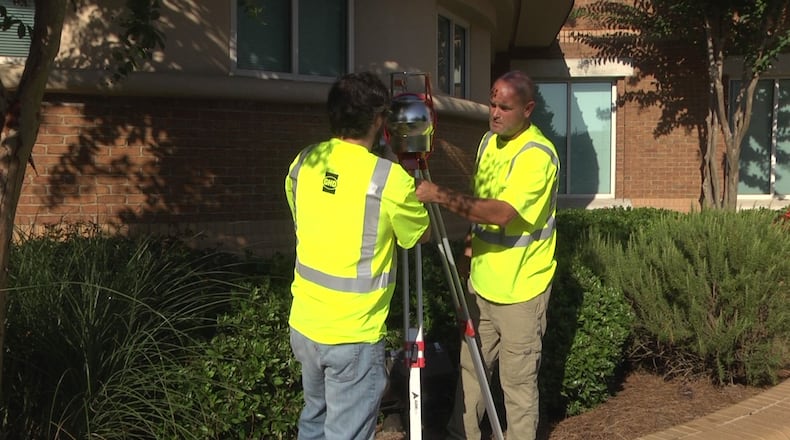State regulators said Thursday that high levels of a carcinogenic gas detected in Covington are "very concerning," and expressed regret about not informing the public earlier about the risks posed by a chemical used as a sterilizer and in manufacturing.
The joint meeting between the Cobb and Fulton county legislative delegations was intended to focus on emissions from Sterigenics, a Cobb company that uses ethylene oxide to sterilize single-use medical equipment.
Phil Macnabb, the president of Sterigenics, told the legislators that his facility is safe and follows regulations.
The meeting came one day after the Covington City Council called for another sterilizer, BD Covington, to temporarily suspend operations after independent air tests near its facility showed ethylene oxide concentrations reaching as high as 15 micrograms per cubic meter. Federal regulators say lifetime exposure to 0.02 micrograms per cubic meter could result in an elevated cancer risk.
Rep. Pam Dickerson, D-Conyers, applauded the call for closure on Thursday, saying she was “alarmed” by the testing results.
“Those levels are very concerning,” said Karen Hays, the head of the state’s air protection division at the Georgia Environmental Protection Division. She said they represented an “unacceptable” risk of cancer.
Both Hays and Rick Dunn, the state EPD director, said the department had struggled with its response to news of a federal report that warned that some census tracts in Georgia might be at risk for higher rates of cancer due to exposure to ethylene oxide. Residents in metro Atlanta didn't learn about the issue until July, after WebMD and Georgia Health News ran an article calling attention to the federal air toxics assessment, which was released in August 2018.
The Atlanta Journal-Constitution reported this week that regulators in Colorado notified the public there on the day the report was released, started air testing just days later and had convinced a sterilizer to improve emissions controls within a month. Illinois and Michigan also acted more decisively, the AJC investigation found.
“If we had to do this over again, we would notify the public much sooner than we did,” Hays said. “We have learned. There are some lessons we will not forget.”
Still, Dunn said the state EPD does not have a planned response to the high levels of ethylene oxide detected in Covington. That facility had an ethylene oxide leak during the testing period, and Dunn said it was not clear if the leak caused levels of the gas to spike. He wanted a more representative sample.
“When we have a plan, I’ll be happy to share it with you,” he told legislators. “We’re working on it diligently.”
Lawmakers expressed concern that the state still wasn't acting with enough haste for what they consider a grave situation. Sen. Nan Orrock, D-Atlanta, called the Covington testing levels "new and startling information."
“Is that not time to press the red button?” she asked. “Where’s the sense of urgency around what we have just learned? All of this is red alert, in my opinion.”
In a statement, BD Covington said the long-term exposure risk was not properly indicated by the air tests that were being conducted.
“Taking only one value from one location, high or low, and comparing to regulatory limits is not grounded in science,” the statement said.
Air tests occurring in Cobb
Covington is not the only area where air quality is being tested.
Several days of testing were completed after the Sterigenics plant near Smyrna shut down to install more emission controls, and another nine days of testing are planned once it reopens. Fulton County began testing Oct. 9 around Sterilizations Service of Georgia, in unincorporated Fulton County. That testing will be completed Saturday, but it will be mid-November before any results are known. The county will also test an additional four days when Sterilization Service of Georgia suspends operations to make repairs at that facility.
Hays said Sterilization Services of Georgia does not control emissions from a back vent, but the agency has asked the company to add scrubbers there to help capture more emissions. Federal law does not require the scrubbers, but Sterilization Services of Georgia agreed to install them by the end of the year. Sterigenics and BD's facilities have those additional emissions controls.
Additionally, Sterigenics president Macnabb said the company has largely finished enhancements that will capture more of the gas and keep it from being released into the atmosphere. He further said Sterigenics had upgraded its controls after the federal dataset was tabulated and before it was released, and continued to add upgrades this year.
“The risk analysis does not reflect what the facility looks like today,” he said. “This facility operates safely, and it is not a risk to public health.”
Macnabb also said he understood that people were scared, and wanted information.
“I would have moved faster in communicating with the state and with the community,” he said. “People were surprised that we’re there.”
Rep. Erick Allen, D-Smyrna, asked Macnabb if Sterigenics would pledge to continually monitor and report its emissions, but Macnabb said he would not.
“I’m really not here to make commitments to the group,” he said.
Several residents came to the hearing advocating for the plant to be shut down, as one in Illinois was this year. Janet Rau, the president of Stop Sterigenics Georgia, said she didn't believe she could trust the company or the EPD with residents' health.
“We’re not safe right now,” she said.
About the Author
The Latest
Featured


